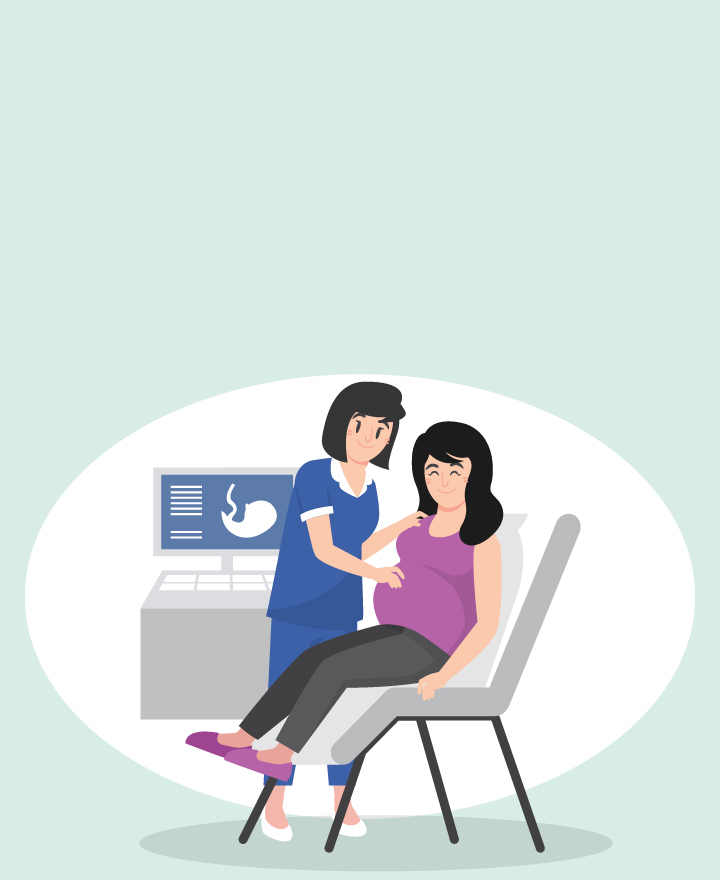

Back and Pelvis Care During Pregnancy: A Complete Guide
Pregnancy can put a significant strain on your back and pelvis, but simple steps can help alleviate the discomfort. This guide covers essential tips to reduce pain, stay comfortable, and support your body throughout your pregnancy journey. Read on to know more.
How to Take Care of Your Back and Pelvis During Pregnancy
Here are some effective ways for back and pelvis care during pregnancy and reduce strain:
1. Pelvic Floor Strengthening
Strong pelvic floor muscles help keep your bladder, uterus, and bowels in the correct position. During pregnancy, these muscles bear increased weight, which may lead to pelvic instability and discomfort. This is where targeted exercises, such as Kegels, can help.
To perform Kegels during pregnancy, first empty your bladder. Sit or lie down in a relaxed position, then squeeze the muscles you would use to stop yourself from peeing. Hold your position for 5 seconds, then relax for 5 seconds. Repeat 10–15 times, thrice daily.
2. Support Proper Posture
Pregnancy shifts your centre of gravity forward due to the growing uterus. To compensate, many women unknowingly arch their lower back more than usual, which puts stress on the lumbar spine and pelvis. Maintaining correct posture helps disperse your body weight and reduces unnecessary pressure.
Keep your shoulders back, ears aligned with your shoulders, and avoid locking your knees. When standing, slightly bend your knees and shift your weight between both legs. When sitting, ensure your back is straight with both feet flat on the floor. Avoid slouching or sitting with legs crossed.
3. Get a Maternity Support Belt
A maternity support belt can ease pressure on your lower back by gently lifting your growing belly, especially during the second and third trimesters. It helps reduce spinal strain and adds stability to your pelvic region. Choose a well-fitted belt with adjustable straps and breathable fabric for added comfort. While helpful during long periods of standing or walking, it should not replace good posture or regular prenatal exercise. For added peace of mind during pregnancy, consider investing in a health insurance plan that covers maternity-related needs, including support aids and prenatal care.
4. Support During Sleep
Sleeping position matters during pregnancy, especially since you remain in one posture for hours. Lying on your left side is ideal as it boosts blood circulation to your baby. Support your body with a wedge or full-body pillow between your knees and under your belly to ease pressure on your spine and pelvic joints. This helps reduce back strain and keeps your posture aligned. After the first trimester, avoid lying on your back to prevent pressure on key blood vessels and minimise discomfort.
5. Use Warm Compresses
If you experience persistent back or pelvic pain, try applying a warm compress to the affected area of your lower back. Doing this relaxes tight muscles and improves blood circulation to the area. You can use a hot water bottle or a microwaveable heat pad wrapped in a towel to prevent direct skin contact. Make sure you limit heat application to 15-20 minutes at a time. Do not use electric heating pads unattended or while sleeping. Avoid very hot compresses, especially around the abdomen.
6. Manage Weight Gain
While weight increase is a natural part of pregnancy, excessive or rapid gain can place unnecessary pressure on your lower body. It is important to follow a balanced diet consistently. Ensure your meals contain the right mix of protein, calcium, iron, and fibre to support healthy weight gain. If you continue to gain weight, even though your baby’s growth is progressing normally, consult a qualified nutritionist or gynaecologist to create a diet plan tailored to your stage of pregnancy. Having family health insurance during this time can help cover consultations, prenatal checkups, and any unexpected medical expenses, ensuring better care for both you and your baby.
7. Choose Footwear Wisely
As your weight increases, your foot arch may flatten, altering how you walk and affecting your spinal alignment. Purchase shoes with good arch support, cushioning, and a wide base to maintain balance. Avoid wearing high heels or fully flat shoes, as both can disturb your alignment and increase pressure on your lower back. Proper footwear helps disperse weight, reduces the risk of falls, and can alleviate discomfort from conditions such as pelvic girdle pain or sciatica.
8. Avoid Heavy Lifting
Lifting heavy items or twisting your upper body can aggravate back pain and pelvic instability. The ligaments around your spine and pelvis are naturally looser because of the hormone relaxin, which increases the risk of injury. If you need to lift something, bend your knees rather than your waist, keep the object close to your body, and use your legs to lift.
Conclusion
Taking care of your back and pelvis during pregnancy is all about being mindful of your posture, movements, and daily habits. To achieve optimal results, perform Kegels, sleep in the correct position, wear supportive shoes, use a maternity belt, and avoid heavy lifting. You must also manage your weight and use warm compresses when needed to ease discomfort. These small changes can keep you more comfortable and support a healthier pregnancy overall. Alongside these efforts, having a proper health insurance policy ensures you are better prepared for any medical support you may need during this journey.
One of the important components of our overall wellness is also being financially secured. Healthcare emergencies can happen any time, but a good health insurance policy can protect you from such uncertain situations. To know more about Wellness and other health related tips, visit the wellness corner.
Sources: acko.com, mayoclinic, myclevelandclinic
Disclaimer: This blog provides general information and discussions about health and related subjects. The information and other content provided in this blog, website or any linked materials are not intended and should not be considered or used as a substitute for medical advice, diagnosis, or treatment. Kindly contact your doctor before starting a new medicine or health regime.
Related Articles
Kegel Exercises - Exercises for Pelvic Floor
Baby Dropping Symptoms and Signs Your Baby Has Dropped
Endometriosis: Causes, Symptoms, Treatment
Ovarian Cysts: Symptoms, Diagnosis, and Treatment
Published on July 17, 2025















 Health Insurance
Health Insurance  Travel Insurance
Travel Insurance  Car Insurance
Car Insurance  Cyber Insurance
Cyber Insurance  Critical Illness Insurance
Critical Illness Insurance
 Pet Insurance
Pet Insurance
 Bike/Two Wheeler Insurance
Bike/Two Wheeler Insurance  Home Insurance
Home Insurance  Third Party Vehicle Ins.
Third Party Vehicle Ins.  Tractor Insurance
Tractor Insurance  Goods Carrying Vehicle Ins.
Goods Carrying Vehicle Ins.  Passenger Carrying Vehicle Ins.
Passenger Carrying Vehicle Ins.  Compulsory Personal Accident Insurance
Compulsory Personal Accident Insurance  Travel Insurance
Travel Insurance  Rural
Rural